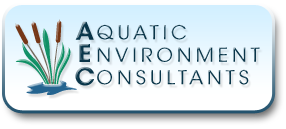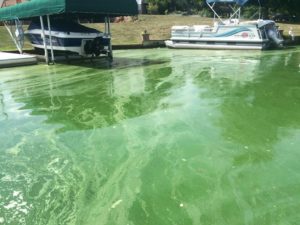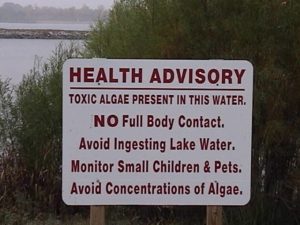Updated: 5/6/2019
Algae blooms are one of the most common problems in lakes and ponds of all sizes. They are also one of the most difficult to remediate. Excessive algae growth is a sign that the ecosystem of your lake or pond is out of balance. Effective control requires addressing the underlying problems and performing ongoing maintenance and monitoring to prevent them from recurring.
If you’re concerned about harmful algae blooms in your lake or pond, read on to learn more about the risks and what steps you can take to protect yourself.
Toxic Algae Blooms: 7 Things to Know
1. What Is An Algae Bloom?
Phytoplankton are microscopic algae that is present in any aquatic ecosystem. In a well-managed lake or pond, they play an important role in producing nutrients and maintaining the health of fish and other native flora and fauna. However, when a lake or pond’s ecosystem is out of balance, it can lead to unchecked growth of algae populations, known as blooms.
Some algae blooms are known for the toxins they release into the water. If left to grow, they can have a severe impact on human health. However, even some non-toxic algae blooms can harm the environment and economy. Toxic and non-toxic harmful algae blooms pose an environmental threat in areas nationwide.
Algae blooms are most common in the spring and summer months, when sunlight and rising water temperatures create ideal conditions for growth. They have a characteristic appearance, often described as “pea soup-like” or “like spilled paint.” Algae blooms can be blue, green, gray, red, brown or a number of additional colors.
If you know or suspect that your lake has an algae problem, do not drink from or swim in it. Certain harmful algae bloom toxins can make humans or animals very sick.
2. What Causes Toxic Algae Bloom?
Toxic algae blooms occur when colonies of harmful algae grow excessively, which has negative effects on people, animals and the surrounding environment. No one knows for sure what exactly causes these colonies to develop. They can occur in both freshwater and saltwater environments in nearly any aquatic system. However, we do know that algae blooms need certain elements for optimum growth, including:
- Nutrients like nitrates and phosphates
- Sunlight
- Slow-moving water
Scientists have noticed that algae blooms thrive when conditions like wind and water currents direct them together, as well as warm temperatures and extreme events like floods or hurricanes. Nutrient overloads in the surrounding water from human activity can also contribute to algae’s growth.
Harmful algae blooms will become more frequent and more severe as the earth’s climate continues to change. We can expect to see more of these blooms long into the future.
3. How Are Humans Exposed to Toxic Algae Bloom?
People and animals can become exposed to a harmful algae bloom in many ways, and this exposure can severely damage their health. If your homeowners’ association, country club or other facilities maintain a pond or lake with an algae bloom, you could expose yourself to these toxins by:
- Fishing in the contaminated water and eating the fish or seafood you catch
- Breathing the air around the contaminated area
- Obtaining drinking water from the contaminated lake
Even if you cook your seafood or boil your water, the toxins will remain present and could cause severe side effects. You can prevent algae bloom exposure by following federal regulations surrounding the safety of recreationally caught seafood and various sources of drinking water.
4. Why Are Algae Blooms Harmful?
Algae blooms are harmful because, they can contain toxins. Cyanobacteria — also known as blue-green algae — can contain powerful toxins associated with a number of negative health consequences, including:
- Skin and eye irritation, allergic reactions such as rashes and sores, asthma and other conditions
- Stomach cramps, vomiting, nausea, diarrhea, headaches and potentially even long-term liver damage
The toxins in algae blooms affect both humans and animals. Pets, livestock and wild animals that drink pond water contaminated with cyanobacteria can become very sick due to toxic algae poisoning.
Aside from these harmful health effects, algae blooms have many other negative impacts on the world around us, including:
- Increased treatment costs for drinking water
- Economic harm to industries that rely on clean water — such as seafood, fisheries, tourism and restaurants
- Closed beaches
- Dead areas of the water
- Oxygen depletion in the water
 5. Toxic Algae Blooms and the Ecosystem
5. Toxic Algae Blooms and the Ecosystem
Cyanobacteria isn’t the only serious problem associated with toxic algae blooms. Excessive algae growth throws aquatic ecosystems completely out of balance, depriving fish and plants of oxygen and important nutrients. This can lead to the creation of dead zones — also known as hypoxia — in larger bodies of water.
Runoff from contaminated lakes and ponds can have major consequences as well. Nearby watersheds can become tainted, causing the problem to spread and potentially affecting the supply of drinking water or water used for agriculture.
6. How Can I Prevent Toxic Algae Bloom From Growing in My Pond?
Fortunately, you can take several steps to keep harmful algae bloom from growing in your lake or pond if you haven’t yet noticed any growth. These steps include the following:
- Properly dispose of your grass clippings, garbage and other materials to prevent them from gathering in your lake or pond.
- Contact a professional for commercial phosphorous-reducing remedies if your body of water has ongoing nutrient problems.
- Introduce beneficial bacteria to your pond or lake.
- Hire a professional who can regularly test your water quality and proactively correct potential issues before they become more severe.
7. How Can Algae Problems Be Corrected?
Correcting toxic algae blooms already produced in your pond or lake is a more complex task than preventing them in the first place. However, correction of the problem is still available. A professional can eliminate your algae problems through a personalized treatment plan and ongoing monitoring.
Fixing harmful algae blooms requires correcting the underlying problems that led to their growth in the first place. Because the toxins in algae blooms can spread rapidly, early intervention is key. This can include a combination of product, mechanical, physical and biological interventions. Adding an aerator or fountain or introducing beneficial fish populations are other options that should be considered as well.
Once steps have been taken to correct the problem, ongoing monitoring is essential. If you plan on using your lake or pond for recreation, professional testing is absolutely required before exposing yourself to a potentially harmful situation.
Your Partner for Algae Management
If you suspect your lake or pond is experiencing a harmful algae bloom, contact Aquatic Environment Consultants (AEC) right away. We can provide testing and consulting to assess the severity of the problem and develop a comprehensive remediation plan. Call or email our office for assistance.


 5. Toxic Algae Blooms and the Ecosystem
5. Toxic Algae Blooms and the Ecosystem